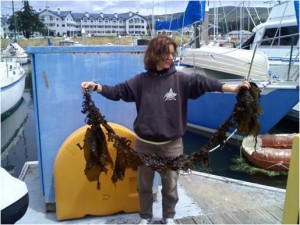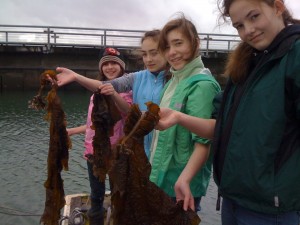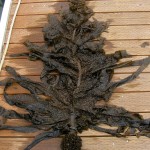by Monaca Noble
Over the last two years, more than 150 volunteers have been working to remove an invasive Asian kelp from marinas in San Francisco Bay.
Undaria pinnatifida, also known as Asian Kelp, Wakame or just Undaria, is a fast-growing kelp that fouls ship hulls, nets, fishing gear, moorings, ropes and other marine structures. As a fouling species, Undaria causes economic and ecological damage and competes for light and space with native organisms, altering their ecosystems. The kelp is native to the northwest Pacific – Korea, China, Hong Kong, and Japan – where it is cultivated for food. But starting in the 1980s, it appeared in France, New Zealand, Australia, Argentina, and California.The first discovery in California occurred at Cabrillo Beach, Los Angeles in 2000. Later it appeared in several locations in Southern California, including Santa Barbara Harbor and near Santa Catalina Island. Within a year it had spread to Monterey Harbor. Unfortunately, attempts to control its spread in Santa Barbara and Monterey harbors were launched late and were underfunded. Undaria moved north and by 2009 had established itself at Pillar Point Harbor in Half Moon Bay, the San Francisco Marina and South Beach Harbor Marina in San Francisco Bay.
Lead Scientist Dr. Chela Zabin from the Smithsonian Environmental Research Center (SERC), with the help of others from the University of California-Davis, the California State Lands Commission, the US Fish and Wildlife Service, the National Oceanic and Atmospheric Administration and the US Department of Agriculture, has been working with community groups such as San Francisco Baykeeper and local volunteers to remove the kelp by hand from infested marinas. Dr. Zabin has hosted numerous removal events starting in July 2009 and has led over 150 volunteers in the effort. Dr. Zabin and her colleagues also led education campaigns encouraging boat owners, harbor visitors and divers to inspect and remove kelp from their boat hulls, slips, moorings, docks and piers.
From July 2009 to July 2011, volunteers removed 450 pounds of Undaria from San Francisco Marina, 419 pounds from South Beach Marina and 13 pounds from Pillar Point in Half Moon Bay. A local aquarium, Aquarium of the Bay, “adopted” a fourth site, removing 32 pounds over two months.

Dr. Chela Zabin, contemplating one sample of the 900-plus pounds of kelp she and her colleagues eliminated over the last two years. (Credit: SERC)
The removal efforts have been unfunded since March 2011, so successful management of the pest is dependent on volunteer efforts. Volunteers plan to continue the project, with the idea of having individuals or groups “adopt” a single marina. In the meantime, a small grant to SERC from California Sea Grant is funding the development of a web-based citizen science early detection program.
Carliane Johnson, a marine biologist who recently moved to California from the East Coast, volunteers her time to remove Undaria because she knows firsthand how harmful non-native and invasive species can be to an ecosystem.
“I’m originally from Florida, where non-native plants and animals have also caused a lot of damage. It’s very difficult to completely remove these invaders, but I’ve seen the positive results when people remain diligent.” While in her 70s, Johnson’s own mother singlehandedly removed invasive melaleuca trees from her two-acre property in South Florida. Since the 1930s these 50- to 70-foot trees have been spreading over the Everglades, jeopardizing several already endangered species. “It took my mother years to remove the mature trees, and she continues to pull new sprouts, but she was successful. Since Pillar Point Harbor is my backyard now, I hope to do the same here with Undaria.”
Marianne Kavanagh,a research biologist and volunteer with the Association for Women in Science, East Bay, Califonia Chapter, has exposed young girls to field research by bringing them out as removal volunteers. “It is one thing to read about the scientific process after the studies have been reported, published, and printed in biology textbooks, but quite another to participate in ongoing studies such as these,” says Kavanagh.

The Association for Women in Science recruited several local students to help clear away kelp from the Bay. Left to right: Gemma (13), Brianna (14), Isabel (13), and Morgan (16) (Credit: Marianne deCarvalho-Kavanagh)
“It was a great feeling to be protecting the San Francisco Bay from Undaria,” says 16-year-old Morgan, one of Kavanagh’s volunteers. “Most people don’t realize that even doing something simple like taking Undaria out of the Bay will help our ocean survive and be prosperous.”
If you would like to help the volunteers protect San Francisco Bay and learn about scientific research, visit the marine invasions website and contact Dr. Chela Zabin (zabinc@si.edu, 415-435-3528) to sign up for the next removal event or for information on how you can adopt a marina.


